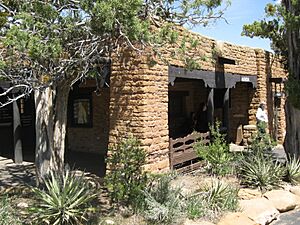Chapin Mesa Archeological Museum facts for kids

Entrance of the Chapin Mesa Archeological Museum
|
|
| Location | Mesa Verde National Park |
|---|---|
| Type | Archaeological museum |
The Chapin Mesa Archeological Museum is a special place in Mesa Verde National Park, Colorado. It's an archaeological museum, which means it helps us learn about people who lived a long, long time ago. The museum is a key part of the Mesa Verde Administrative District, which became a National Historic Landmark in 1987.
Contents
Museum Building: A Look Back
The museum building itself is quite old, built between 1922 and 1925. It was designed in a style called Pueblo Revival, which looks like the ancient homes of the Pueblo people. This style is part of something called "parkitecture." This is a fun name for park buildings that are made to blend in with nature and local traditions.
The museum is one of six buildings in the park made from local buff sandstone. It also features wooden beams called "vigas" that stick out from the walls. These design choices help the building feel like it belongs in the park. A very important person, John D. Rockefeller Jr., helped pay for the museum's construction.
The museum is located on Chapin Mesa, close to Spruce Tree Canyon. From behind the building, you can see Spruce Tree House. This is one of the biggest and best-preserved cliff dwellings in the entire park.
What You Can See: Museum Collections
Inside the museum, you can watch a short film. This film tells you all about Mesa Verde National Park and the history of archaeological work done there. You'll also see many cool artifacts. These are items found from ancient times, like pottery, baskets, woven items, tools, and things people used in their homes.
A really neat part of the museum is its five dioramas. These are 3D models that show what life was like for the Ancestral Puebloans. They cover a huge period, from 13,000 BCE all the way to 1200 CE. These dioramas were made by members of the Civilian Conservation Corps in the 1930s. They are now important historical items themselves!
In recent years, there have been exciting updates to the museum. A project started to make the exhibits even better. This included taking care of the old dioramas and getting new display cases. The goal is to make the exhibits more interactive. For example, a special augmented reality (AR) mobile app is being developed. If you download the app to your phone, it can add digital figures over the dioramas. This makes the ancient scenes come alive and helps you learn more about the Ancestral Pueblo people.
Museum Renovations
The museum was temporarily closed for renovations starting in October 2021. These updates helped make the museum even better for visitors.
See also
- Frederick H. Chapin
- National Park Service rustic "parkitecture"

